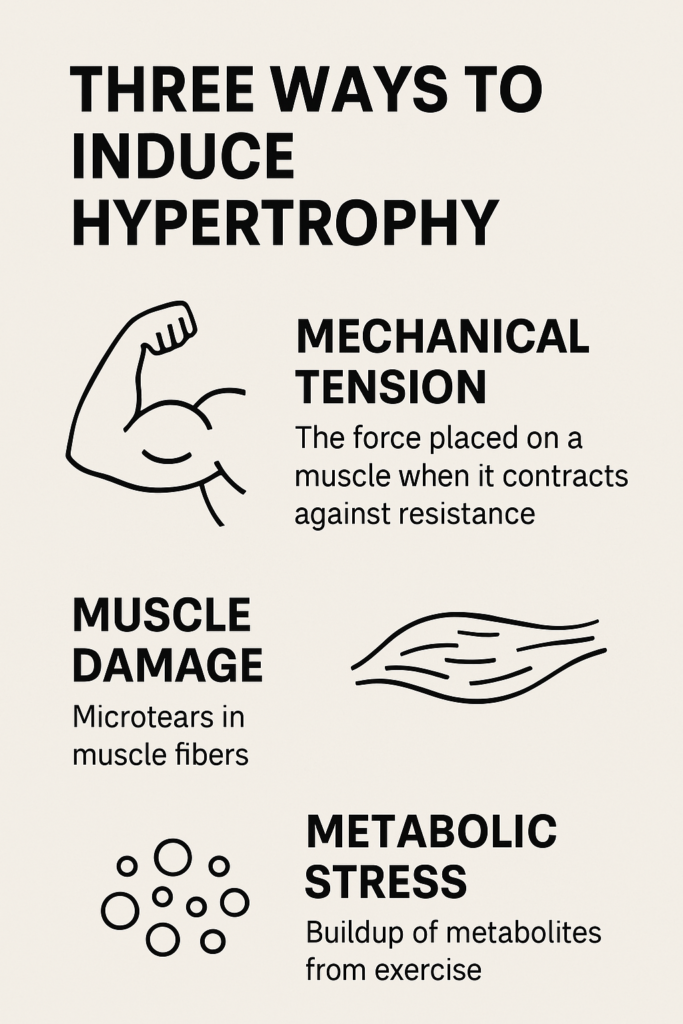Your cart is currently empty!
Why Gym Bros Are Stupid
We all know know the people that hit the gym 6 days a week, going through the classic back and bi’s, chest and tri’s, and leg day splits, but what many don’t understand is this is not only suboptimal to gain strength and muscle mass, but can even be counterproductive. Hypertrophy (increase in musce size) is a nuanced and complex topic that is widely misunderstood by the general public.
What is Required for Hypertrophy?
Popularized by Brad Schoenfield, a researcher and exercise physiology professer, the idea that there are three ways to induce muscular hypertrophy has been widely accepted across researchers and those involved in the science of muscle. The three ways to elicit hypertrophy are mechanical tension, metabolic stress, and muscle damage, but the catch is that it has been proven only one of these mechanisms is needed to grow larger muscles.

The only neccessary mechanism for hypertrophy is mechanical tension, meaning that while that feeling of a “pump” in the form of metabolic stress, or the muscle damage during eccentric exercise may have impacts on hypertrophy, but the only critical element of growing larger muscles is mechanical tension.
How Does Mechanical Tension Work?
If mechanical tension is the only stimulus needed to elicit gains in muscle mass the biological mechanism of tension is important to know when creating programs that seek to increase size and strength. When a load is great enough that it places a significant demandn on the muscles and body, receptors that are a part of your nervous system called mechanoreceptors found within each individual muscle fiber sense the tension and start a signaling cascade. These receptors initiate signaling proteins that relay the message to the nucleus, or control center, of the cell. Once the nucleus recieves this message it begins initiating signaling pathways within the body that promote proteins synthesis within the muslces. These newly created proteins join the existing makeup of the muscles leadng to larger and stronger units of muscle.
In short, placing high loads on your muscles starts signaling pathways within the body that communicate to your muscles they need to grow in order to be able to handle the load.

How About Metabolic Stress?
Metabolic stress, while not inherently neccessary for muscular growth, can be beneficial in stimulating hypertrophy. When we place difficult demands on the body through exercise such as high repitition sets with short rest periods. These longer sets burn through your body’s stored energy reserves, forcing the build-up of “metabolites” or exercise-induced waste products like lactate as you try to create more energy under stress. This metabolic stress can be beneficial to eliict hypertrophy, but only when the mechanical tension is high enough to signal the body to grow like we talked about earlier. When metabolic stess is induced with low load weights, the hypertrophic benefits of the waste product accumulation aren’t used and hypertrophy fails to occur.
The Destruction of Muscular Damage
Muscular damage can have beneficial effects on hypertrophy when kept in moderation. The damage elicited by exercise, largely eccentric exercise or the lowering of load like coming down on a back squat, causes inflammation in the muscles, signaling immune cells that repair the muscle and add potential adaptations to enter the muslce and repair it. The problem is that this muscle damage is largely overdone with muscles not getting the proper recovery before the next destructive workout. Research has indicated hat muscle damage kept in low to moderate amounts when combined with mechanical tension elicits the greater hypertrophic response. When trainees enter the weight room on a daily basis and perform highly destruyctive movements on their muscles, how can we ever expect to recover from this damage without extended recovery periods that are neglected? Especially for athletes who have skill training, practice, and games, how can we ever expect this muscle damage to be recovered from? Muscle damage is so easily over done and impairs the bodys ability to prepare for the next training bout.
How Can We Use These Ideas To Our Advantage?
If mechanical tension is the only requirement for hypertrophy, metabolic stress can be beneficial in combination with load, and muscular damage is largely overdone and should be kept in check, the current state of gym bro training across the world needs to be revamped. By using partial repititions that place more tension on the body than ever possible with full range of motions we can get maximal mechanical tension on our muscles. When these partial ranges of motion are perfomed, higher repitition sets with large mechanical tension become possible creating an environment optimal for hypertrophy. On top of this, the relatively small eccentric portion of the exercise compared to the long and dragging full range of motion eccentrics elicits minimal muscle damage in theory supporting healthy recovery and hypertrophic signaling. Partial repititons reign supreme again, allowing for maximal hypertrophic benefits in your bodys optimal range of motion.

Leave a Reply